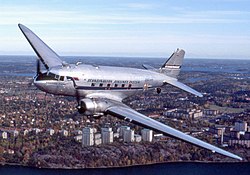Plot

After Flight 107, a propeller-driven Douglas DC-3 from Buffalo operated by Trans East Airlines, lands safely with no crew or passengers aboard, the FAA sends Grant Sheckly, an inspector with 22 years of experience and proud of his flawless record of solving cases, to investigate the matter. He is assisted by the airport staff — vice president Bengston, PR man Malloy, mechanic Robbins, and ramp attendant Cousins — but despite their combined efforts, no one can explain how an empty plane could safely land and taxi to a stop. Sheckly is nagged by the familiarity of the pilots' and passengers' names.
The investigation continues to prove fruitless until Robbins remarks about the plane's blue seats, which puzzles Sheckly, who remembers them from when he entered the plane as being brown. Bengston further says they were red. When they examine the plane's tail and each see different registration numbers, Sheckly claims the plane is not real, merely an illusion each of them has imagined somehow.
To prove his hypothesis, as well as to break the illusion, Sheckly proposes a simple, yet potentially fatal, test: he will put his arm in the arc of the plane's turning propeller. Despite their objections, he convinces the staff to go along with it, and Robbins starts the plane's engines. After some hesitation, Sheckly places his arm directly into the spinning propeller; just as he predicted, his arm remains unharmed, and the plane vanishes. However, when Sheckly successively turns to the others, he is met only with silence as they each disappear, just as the plane did.
Calling out for the staff, Sheckly makes his way back to the Operations room where he finds Bengston and Malloy, only to discover that they have no recollection of the empty plane or Sheckly's investigation. When asked, Bengston states that Flight 107 landed safely with full crew and passengers and shows him a newspaper article to prove it. But as Sheckly continues to press them about losing "Flight 107", Bengston remembers that the only plane the airline ever lost was a Flight 107, 17 or 18 years previously. The case had been investigated by Sheckly but was never solved, the only case he never figured out, closed as "presumed crashed for reasons unknown" at sea. Sheckly staggers away and wanders through the airfield he calls out, demanding to know the fate of Flight 107, then slumps onto the ramp as the sound of an aircraft's jet engine is heard passing overhead.